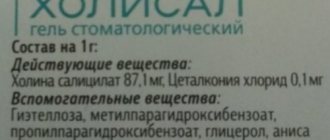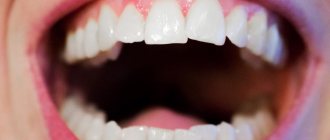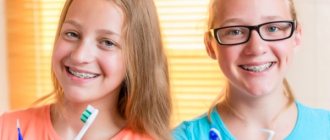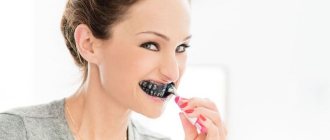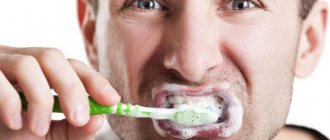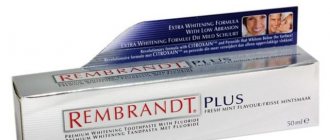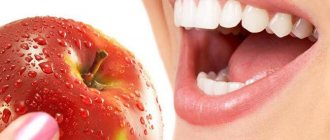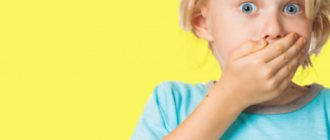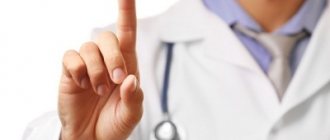Everyone knows that baby teeth will fall out and permanent teeth will appear in their place. But some people misunderstand this fact and conclude that it is not worth caring for temporary teeth. They brush the child’s teeth rarely and reluctantly, but without knowing it, they harm the baby’s body. The reason is that the accumulation of bacteria in the mouth does not go away: it grows unhindered and passes on, provoking the occurrence of problems that are outwardly in no way related to the oral cavity. In addition, a lax attitude towards hygiene quickly becomes a habit, and parents continue to make more and more mistakes along with a child who has never learned to pay due attention to a smile. Therefore, you need to start brushing your child’s teeth correctly starting from the first year of life. But how? The whole process was described in detail by Doctor Zubastic.
Scope of work
Often the first teeth appear as early as 6 months. As a rule, these are the lower central incisors. However, if the Rubicon is passed, and not a single fighter is there, it’s okay: these are the features of your child’s development. The alarm should be raised when the baby is already over a year old, and not a single tooth appears on the horizon. There should be 20 teeth in total: ten on each side.
Here is a sample dental schedule:
| Lower central incisors | 6-10 months. |
| Upper central incisors | 8-12 months. |
| Upper lateral incisors | 9-13 months. |
| Lower lateral incisors | 10-16 months. |
| Upper canines | 16-22 months. |
| Lower canines | 17-23 months. |
| Lower molars | 23-31 months. |
| Upper molars | 25-33 months. |
Dr. Zubastik recommends
Teach your child to brush his teeth in such a way that the procedure gives him pleasure and looks like a game. You need to start seriously from 1–2 years old, no later.
- Patiently and persistently instill in your baby a desire for cleaning. A toddler who does not experience negative emotions will be able to visit the dentist in the future without fear.
- Don't let children use your hygiene products! If there is no baby paste, it is better to use only a brush dipped in water.
- Change the brush every 3 months.
It is necessary to monitor the condition of the oral cavity by visiting the dentist from the age of one and a half years.
Tags: children
About the author: Dr. Zubastik
Typically, a toothache begins to subside on the way to the clinic and finally goes away after 10 minutes of sitting in line to see the dentist.
- Related Posts
- All the nuances of flossing teeth
- 6 recommendations after brushing teeth from tartar
- What instruments are used to clean teeth?
« Previous entry
Instructions for mom
When should you start brushing your baby teeth? You need to start from the moment they appear. Don't think that these are temporary consumables. Here is an important part of the development of the baby’s body, which is responsible for the formation of a correct bite, jaw development and the harmonious functioning of the digestive tract. We have written in detail about why we should all take regular care of our oral cavity in a short explanation.
To properly brush the teeth of a child up to one year old and at one year old, you need to stock up on clean gauze or special silicone attachments for brushing teeth. These are the step-by-step instructions for parents:
- Wash your hands thoroughly;
- We wrap a piece of clean, damp gauze around our finger in several layers or put on a special silicone nozzle;
- Slowly, without strong pressure, stroke the surface of the teeth up and down, 2-3 minutes is enough;
- We repeat the procedure after each meal so that its particles do not feed bacteria, creating the likelihood of caries and other problems in the oral cavity.
- The gauze for the procedure must be changed each time, but the nozzle can be thoroughly rinsed and dried for the next use.
These simple actions are not excluded from everyday life until the baby learns to use a toothbrush. It is worth getting used to it gradually, so that the child can take proper care of himself without pressure from you. By the way, will the next oldest instruction, which teaches how to properly brush children’s teeth, help teach him?
At what age should a child brush his teeth?
Many mothers underestimate the importance of the procedure in question and start teaching their baby to use a toothbrush late. Pediatricians say that brushing the mouth and teeth should begin from the moment the child already has at least one tooth. As a rule, this corresponds to the age of 5-6 months and at this time it is enough to clean the tooth once a day.
Closer to one and a half years, the child will need to be taught to brush his teeth at least twice a day, and if this procedure does not irritate him, then three.
Modern methods
From the age of 1, you can delegate your responsibilities to a pacifier brush. This device has a nozzle that is different from the usual one, but made of safe silicone. Children love to chew on these bristles while they clean his teeth. It is also equipped with a special side that prevents injury. This assistant should work after each meal for 5 minutes. After this, rinse it thoroughly and dry it.
A dummy brush will become a transitional link from a mother’s hand to a full-fledged brush. Already at 15 months you can introduce your baby to the latter. It is advisable to use a game interaction scenario so as not to turn hygiene into a forced or hysterical ritual. Then the child will not show proper initiative and will not take care of himself in your absence.
How many minutes should children brush their teeth?
Everyone knows that they need to be cleaned regularly to prevent diseases of the teeth and gums. But problems still appear even with regular cleaning. What is this connected with? Maybe it's all about the correctness of the procedure being performed? This article will discuss how to properly brush your teeth.
Why is this necessary?
The oral cavity is one of the weakest places in the human body, which easily becomes inflamed in the absence of proper care. The leftover food begins to rot in the mouth and ferment. Plaque eats away the enamel.
All this leads to such unpleasant diseases as caries and periodontitis. Not only does bad breath form, but problems can also spread to internal organs, and the infection can easily progress further.
The result can be such unpleasant diseases as gastritis, colitis, etc.
Is teeth cleaning necessary? Of course. Even in prehistoric times, people cleaned them using wooden sticks and plants. But since those times, modern people have not learned how to take care of their oral cavity with their entire composition.
And the question “how long should you brush your teeth for a good result?” is still relevant in our times. Suffice it to say that in Chinese villages, fifty percent of residents in the 21st century have never used a brush. As a result, they show off gaps in their mouths, which, of course, does not decorate anyone.
Moreover, this cannot be considered an example for blind copying.
So how do you brush your teeth?
Despite the fact that everyone was taught at school how to brush their teeth, some of these lessons passed by without leaving even a shadow of useful memories. It must be said that dentists themselves disagree about the correctness. There are many techniques.
Some suggest pressing firmly on the gums during the procedure, while others suggest holding the brush at an angle of exactly ninety degrees.
But today, modern dentists have taken the best from the techniques and issued recommendations that every patient who cares about their health should know:
- hygienic brushing of teeth should last more than three minutes;
- in this case, you need to hold the brush at an angle of forty-five degrees to the surface being cleaned;
- Cleaning must be divided into two stages: first clean the upper jaw, then the lower jaw. The procedure should begin with the front teeth, moving from them to the back;
- teeth are brushed with sweeping movements, from root to edge;
- the chewing part is cleaned with circular movements;
- The tongue also needs to be cleaned. To do this, use the back of the brush, with the pimples, to clean the entire tongue and massage the gums with this part of the brush;
- Finally, rinse your mouth with mouthwash.
How many times a day should you brush your teeth? In the morning after meals and at night: twice a day. You can, of course, clean it more often, after every meal. But at the same time, you need to strictly follow the recommendations of doctors and choose the right brush.
But not everyone can afford such procedures, so you can simply use chewing gum or rinse your mouth with mouthwash or plain water. Many people have been accustomed since childhood to brush their teeth immediately after sleep; this is not a completely correct habit and should be abandoned. Or clean them both after sleep and after breakfast.
Toothbrush
The most important part of brushing your teeth at home is the toothbrush. The final result and the condition of the oral cavity itself depend on its correct choice. According to the degree of hardness, they are divided into hard, medium and soft.
Nowadays, few people have healthy teeth and gums, so a hard toothbrush should not be recommended for regular cleaning. It is better to get by with medium hardness. If the gums are prone to bleeding and the enamel is sensitive, then you should use a soft brush.
The brush itself should be small and narrow, this will only increase its cleaning properties. It needs to be changed every 14-16 weeks.
Which toothpaste is best for brushing your teeth?
The paste is only needed to enhance the cleaning effect of the brush on the surface being treated. Therefore, they consist of foaming elements and abrasives.
But to prevent various diseases, various biological substances are added there that have a positive effect on the microflora and maintain the necessary mineral balance.
To the question “which toothpaste is better to brush your teeth?” there is only one answer - suitable for a particular person and the one he likes.
Soda and salt
But to the question “how to clean your teeth at home?” The popular answer is “using soda and salt.” And although many doctors do not recommend overusing such cleaning, some continue to whiten and clean the oral cavity with salt and soda.
This should not be done constantly, but occasionally. Then the tooth enamel will not suffer so much, and the cleansing effect will be maximum. To whiten teeth with baking soda, apply a small amount of it to a soft brush and massage your teeth.
After this, rinse your mouth and do not eat or drink for two hours.
Salt contains many beneficial substances for teeth; there are many countries that practice salt brushing, which helps remove plaque and prevent the formation of caries and tartar.
But there are several subtleties here. So, you need to take very finely ground salt, which will not damage the enamel, and brush your teeth with it at least once every two days.
How long should you brush your teeth? No more than a minute.
Bracket systems
For many who wear braces, brushing their teeth every day poses additional challenges. After all, small pieces of food are so difficult to get out of a metal structure. Therefore, you have to eat the least fibrous food, and when cleaning procedures, resort to brushes, threads, irrigators and brushes with V-shaped bristles.
The basic rules for cleaning apply to teeth with braces, but there are also some subtleties:
- each tooth must be brushed separately, mentally counting to ten;
- Use a brush to clean between teeth and metal structures;
- It is better to use floss in the interdental spaces;
- in places where the brush cannot reach, you must use an irrigator;
- finish with mouthwash.
False teeth and implants
It is especially important to brush your teeth correctly if you have existing restorations. Plaque and harmful microorganisms sometimes accumulate more on them than on natural teeth.
And if you don’t clean your implants, you can lose them completely: they will become inflamed and simply fall off. And in the case of bridge structures, care is especially required for the spaces between the gums and the crown.
And if your gums bleed when brushing your teeth, then this is a direct reason to immediately consult a doctor.
Veneers and lumineers also require the most careful care, because carious changes can begin in the space between the veneer and your own enamel, which you will not immediately see. In such cases, the use of irrigators - devices that clean the surface with a stream of water - will help out. In addition, this device has a good effect on the gums and makes them healthier. Buying it is not so burdensome for the budget.
But no matter how correctly and scrupulously a person brushes his teeth, he cannot do without a visit to the dentist. Only he will help stop the onset of diseases, sanitize the mouth and give preventive advice, with the help of which a snow-white smile will delight its owner for a long time.
If you liked this article, help make the world a better place!
Source: https://detishki.ahuman.ru/skolko-minut-chistit-zuby-detjam/
Getting used to brushing
If the baby shows interest in the brush, you can switch to it. First you need to give him a new item to play with and explain (show) its purpose. Then switch to a brush and brush the child’s teeth yourself, sometimes switching and letting him repeat the movements. This must be done without nerves and gradually. He will be able to brush his teeth himself only from the age of three, and even then it will not be of absolutely high quality. Therefore, without your observation and participation - nowhere.
The choice of a toothbrush for a child should not be based on his preference, but on the recommendations of the dentist. The baby will be drawn to bright designs, but beauty does not mean convenience. Therefore, we choose a brush according to the following characteristics:
- The handle should not slip in your hands. If a child drops it, he probably won’t wash it. Therefore, she cannot fall.
- It should not have sharp edges, otherwise the baby will easily injure the gums.
- The bristles should be soft, otherwise excessive zeal can damage the gums.
- The head of the brush should be small - suitable for a child.
The main thing in this purchase is its safety. The size table will help you choose the right brush for your child:
| 1-2 years | Up to 1.5 cm | 10 cm |
| 2-5 years | 1.5 - 2 cm | Up to 15 cm |
It is also worth paying attention to the manufacturer. It is necessary to give preference to someone who is known throughout the world and is based on the results of many years of research. Everyone knows such brands, for example, Colgate or Oral-B. Their products are tested and verified according to European quality standards.
We wrote about how to teach your child to brush their teeth on their own here.
Teeth Brushing Sequence
- As in adults, when cleaning the outer and inner surfaces of the teeth, the brush is placed at an angle of 45 degrees to the tooth and sweeping movements are made from the gums to the edge of the tooth. To clean the chewing surface, the brush is positioned horizontally and moved in a circular motion.
- Start by treating the outer surface of the teeth.
- Move to the inner surface.
- Then you should pay special attention to chewing surfaces.
- Don't forget to clean your tongue.
- You can complete the cleaning by flossing your teeth.
Brush care rules
How to properly brush a child’s teeth is already clear, but how to care for his brush. An experienced parent will object that these subtleties are unnecessary: they say, the brushes of all family members are used as standard. But no. The child’s immunity is weaker, he eats more sweets, and his teeth are more vulnerable. This means that it is better to make special demands on the means of hygiene,
- The brush itself must be cleaned before and after the procedure using soap so that harmful microorganisms do not grow there.
- The unit needs to be changed every 3 months.
- It is better not to use any covers for the brush: bacteria live much easier in a humid environment. Store it in a glass, with the bristles facing up, so that it does not come into contact with adult brushes.
Why do children need to brush their teeth?
Many parents believe that the child’s “baby” teeth are temporary, they do not serve any special function: “they will be replaced by permanent ones, then they will need to be cleaned.” This is a wrong opinion! It is very important to brush your teeth from early childhood and there are several reasons for this:
- baby teeth form the correct bite and ensure the correct growth of permanent teeth;
- any teeth are involved in the formation of the bones of the skull, and therefore have a great influence on the formation of facial features;
- if teeth are brushed irregularly, then pathogenic bacteria will enter the baby’s body (from the mouth to the intestines), which can lead to the development of quite serious pathologies;
- If the care of teeth and the oral cavity is not carried out correctly, this will lead to the development of caries not only on “milk” teeth, but also on permanent teeth.
Cleanliness of the oral cavity is the key to healthy teeth in the future. Agree, it is much easier to carry out regular hygiene procedures in early childhood than to subsequently visit the dentist and constantly treat your teeth.
Tsygankova Yana Aleksandrovna, medical observer, therapist of the highest qualification category
10, total, today
( 200 votes, average: 4.63 out of 5)
Cholisal while breastfeeding: is it possible or not?
Stool in infants: norms and possible problems
Related Posts
Do you need pasta?
We touched upon the same question “To be or not to be.” Among specialists there is no single answer. Still, most dentists advocate not using toothpaste until the age of 1.5 years. At such a young age, children do not understand the essence of the process, and rinsing the mouth will smoothly flow into eating toothpaste. It's not worth it.
Which toothpaste should I choose for my child? For the same reason, the first paste must be absolutely neutral for the body so that its inappropriate use does not cause any side effects. Such a composition should not contain:
- Fluorine;
- Dyes;
- Preservatives.
In order not to tinker with formulas and abbreviations yourself, you just need to choose a toothpaste from a well-known brand with a limit of up to 3 years. This tube contains a substance that is completely safe even if absorbed.
After 3 years, you can include fluoride in the toothpaste (it is hardened in the fight against caries), but if the baby still swallows everything that is given to him, then there is no need to risk it.
Thus, the answer to the question of how to brush a one-year-old child’s teeth is quite simple: you need to start small in order to accustom your baby to independent hygiene.
Tags: 1 year, baby toothpaste, baby brush, cleaning baby teeth
About the author: DrZubastik
- Related Posts
- Everything about caring for children's teeth
- Who needs dental hygiene and why?
- How to get rid of tartar at home: folk remedies, brushes and pastes
« Previous entry
How to teach your child to brush their teeth on their own
Quite often, parents are faced with the fact that their child flatly refuses to brush their teeth on their own. In this case, you need to turn the process in question into a game! First, you need to buy him a beautiful, bright and unusual toothbrush. In addition to it, it is worth purchasing “tasty” toothpaste, but only one that you can swallow. Secondly, you can invite your child to play “cleaners” - whoever cleans his teeth better and more thoroughly will receive a prize (for this you should stock up on bright stickers and healthy sweets). Thirdly, you can find films on the Internet about how to properly brush your teeth - demonstrating “requirements” in action often has a positive effect on the baby’s desires.
Usually, by the age of 4-5 years, children can brush their teeth independently. If parents taught their child to this hygienic procedure from a very early age, then brushing teeth will become a habitual “event.”
